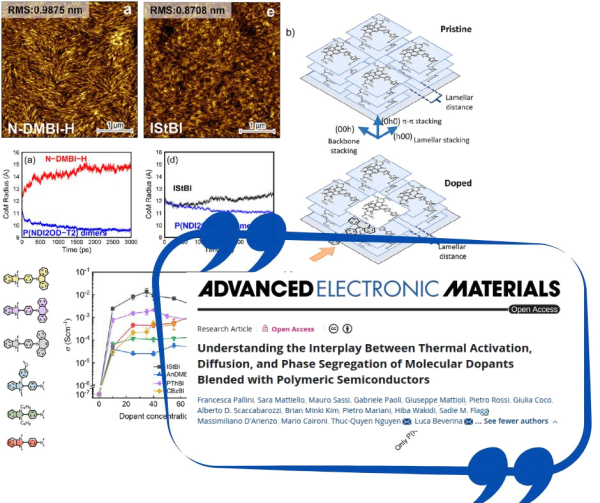Molecular doping is a key approach to tuning charge transport, energy level alignment, and charge injection in printed organic electronic devices. However, n-type doping remains particularly challenging due to the inherently low electron affinity of high-performance polymeric semiconductors. To address this, researchers often rely on precursor dopants like N-DMBI-H, which are air-stable and can be thermally activated to form reactive doping species in situ. Yet, thermal activation not only triggers doping but also leads to dopant diffusion and phase segregation. These effects alter the blend morphology and can reduce electrical performance. In this study, six dopants were investigated in blends with the model polymer P(NDI2OD-T2). It was found that dopants featuring π-extended aromatic units—such as IStBI, PThBI, and CBzBI—exhibit stronger interactions with the polymer, which limits phase separation and results in improved conductivity. Conversely, 2C4-DMBI and AnDMBI show a stronger tendency to segregate, compromising performance. Here, atomistic simulations played a crucial role in linking the molecular structure of dopants to their diffusion behavior and segregation tendencies—phenomena that are often difficult to probe directly in experiments. Computational insights helped explain why specific structural features favor efficient doping, by minimizing thermally activated separation from the host polymer. These findings support a design strategy that goes beyond traditional solubilizing groups, highlighting the importance of dopant-polymer interactions in achieving high charge carrier densities at moderate doping levels. Notably, the iminostilbene-functionalized IStBI demonstrated record performance, validating this approach.
This work is the result of a collaboration between the researchers of: CNR-ISM, Università di Milano Bicocca, Politecnico di Milano, Istituto Italiano di Tecnologia, University of California Santa Barbara, Georgia Institute of Technology.
The authors gratefully acknowledge the support received from:
MUSA (Multilayered Urban Sustainability Action) – a project funded by the European Union–NextGenerationEU under Italy’s National Recovery and Resilience Plan (PNRR), Mission 4 Component 2 Investment Line 1.5: enhancement of research infrastructures and creation of “innovation ecosystems” for the emergence of “territorial R&D champions” – and from the PRIN-PNRR project INPOWER (P2022PXS5S);
The Materials Research Science and Engineering Center (MRSEC) at the University of California, Santa Barbara (NSF DMR-2308708, IRG-1) for funding support. The Shared Experimental Facilities of the Materials Research Laboratory were supported by the MRSEC program of the National Science Foundation (Award No. DMR-2308708), as part of the NSF-funded Materials Research Facilities Network;
The staff of the ALBA synchrotron, particularly Dr. Eduardo Solano, and Dr. Jaime Martin (Universidade da Coruña), for assistance with GIWAXS experiments;
The European Research Council (ERC) under the European Union’s Horizon 2020 research and innovation programme for the project “ELFO”, Grant Agreement No. 864299;
Support under the European Union’s Horizon 2020 research and innovation programme for the project “ROBOFOOD”, Grant Agreement No. 964596;
Funding from ICSC – National Research Centre in High Performance Computing, Big Data and Quantum Computing, with the support of the European Union–NextGenerationEU (grant CN00000013), and from the Italian Ministry of University and Research (MUR) under the PRIN-2022 research programme (project “NIR+”).


 English (UK)
English (UK)  Italiano (Italia)
Italiano (Italia)